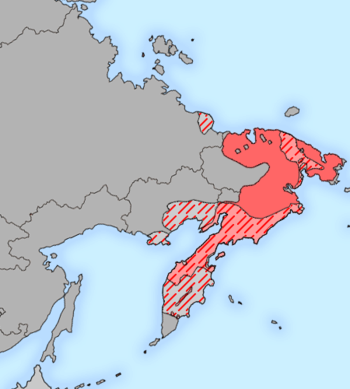- Chukotko-Kamchatkan languages
-
Chukotko-Kamchatkan Chukchi–Kamchatkan, Luorawetlan Geographic
distribution:Russian Far East Linguistic classification: Chukotko-Kamchatkan Proto-language: Proto-Chukotko-Kamchatkan Subdivisions: KamchatkanISO 639-2 and 639-5: cc 
The distribution of Chukotko-Kamchatkan languages (red) in the 17th century (hatching, approximate) and at the end of the 20th century (solid).The Chukotko-Kamchatkan or Chukchi–Kamchatkan languages are a language family of extreme northeastern Siberia. Its speakers are indigenous hunter-gatherers and reindeer-herders.
While the family is sometimes grouped typologically and geographically as Paleo-Siberian, no external genetic relationship has been widely accepted as proven. The most popular such proposals have been for links with Eskimo–Aleut, either alone or in the context of a wider grouping.
Contents
Alternate names
Less commonly encountered names for the family are Chukchian, Chukotian, Chukotan, Kamchukchee and Kamchukotic. Of these, Chukchian and Chukotian are ambiguous, since both terms are sometimes used to refer specifically to the family's northern branch.
In addition, Luorawetlan (also spelled Luoravetlan) has been in wide use since 1775 as a name for the family, although it is properly the self-designation of one of its constituent languages, Chukchi. The derivative Luorawetlanic may be preferable as a name for the family.[citation needed]
Languages of the family
The Chukotko-Kamchatkan family consists of two distantly related dialect clusters, Chukotkan and Kamchatkan. Chukotkan is considered anywhere from one to four languages, whereas there is only one surviving Kamchatkan language, Itelmen.
The relationship of the Chukotkan languages to Itelmen is distant, and has only been conclusively demonstrated recently.
All the Chukotko-Kamchatkan languages are under pressure from Russian. Almost all speakers are bilingual in Russian, and most younger members of the ethnic groups associated with the languages speak Russian only.
Relation to other language families
The Chukotko-Kamchatkan languages have no generally accepted relation to any other language family. They are sometimes classed among the Paleosiberian languages, a catch-all term for language groups with no identified relationship to one another that are believed to represent remnants of the language map of Siberia prior to the advances of Turkic and Tungusic.
Joseph Greenberg identifies Chukotko-Kamchatkan (which he names Chukotian) as a member of Eurasiatic, a proposed macrofamily that includes Indo-European, Altaic, and Eskimo–Aleut, among others. Greenberg also assigns Gilyak (Nivkh) and Yukaghir, sometimes classed as "Paleosiberian" languages, to the Eurasiatic family.
While the Eurasiatic hypothesis has been well received by Nostraticists and some Indo-Europeanists, it remains extremely controversial. Part of the reason for this is that the Eurasiatic hypothesis rests on mass comparison of lexemes, grammatical formatives, and vowel systems (see Greenberg 2000–2002) rather than on the prevailing view that regular sound correspondences, linked to a wide array of lexemes and grammatical formatives, are the only valid means to establish genetic relationship (see for instance Baldi 2002:2–19).
Michael Fortescue, a specialist in Eskimo–Aleut as well as in Chukotko-Kamchatkan, argues for a link between Uralic, Yukaghir, Chukotko-Kamchatkan, and Eskimo–Aleut in Language Relations Across Bering Strait (1998). He calls this proposed grouping Uralo-Siberian.
See also
- Proto-Chukotko-Kamchatkan
- Kamchadal
References
- Baldi, Philip. 2002. The Foundations of Latin. Berlin: Mouton de Gruyter.
- Fortescue, Michael. 1998. Language Relations Across Bering Strait. London: Cassell & Co.
- Fortescue, Michael. 2005. Comparative Chukotko–Kamchatkan Dictionary. Trends in Linguistics 23. Berlin: Mouton de Gruyter.
- Greenberg, Joseph H. 2000. Indo-European and Its Closest Relatives: The Eurasiatic Language Family. Volume 1, Grammar. Stanford: Stanford University Press.
- Greenberg, Joseph H. 2002. Indo-European and Its Closest Relatives: The Eurasiatic Language Family. Volume 2, Lexicon. Stanford: Stanford University Press.
External links
Categories:- Agglutinative languages
- Languages of Russia
- Chukotko-Kamchatkan languages
- History of Northeast Asia
Wikimedia Foundation. 2010.
